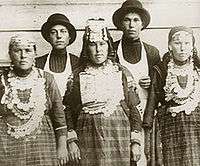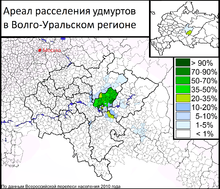Udmurt people
The Udmurts (Udmurt: Удмуртъёс, Udmurt’jos) are a Finno-Ugric people who speak the Udmurt language. In the course of history, Russian-speakers have referred to them as Chud Otyatskaya (чудь отяцкая), Otyaks, Wotyaks or Votyaks (the most-known name). Tatar-speakers call the Udmurts Ar.
 | |
| Total population | |
|---|---|
| 637,000 (2002) | |
| Regions with significant populations | |
| Udmurtia | |
| 552,299 (2010)[1] | |
| 5,824 (2009) | |
| 4,712 (2001)[2] | |
| 193 (2011)[3] | |
| Languages | |
| Udmurt, Russian | |
| Religion | |
| Eastern Orthodox Christianity (Russian Orthodox Church) and Udmurt Vos Minorities: Lutheran, Pentecostal,[4] Islam[5] | |
| Related ethnic groups | |
| Other Permic peoples such as the Komi | |
Etymology
The name Udmurt comes from *odo-mort 'meadow people,' where the first part represents the Permic root *od(o) 'meadow, glade, turf, greenery', and the second part murt means 'person' (cf. Komi mort, Mari mari), probably an early borrowing from an Iranian language (such as Scythian): *mertä or *martiya 'person, man' (cf. Persian mard), which is thought to have been borrowed from the Indo-Aryan term *maryá- 'man', literally 'mortal, one who is bound to die' (< PIE *mer- 'to die'), compare Old Indic márya ‘young warrior’ and Old Indic marut ‘chariot warrior’, both connected specifically with horses and chariots.[6] This is supported by a document dated 1557, in which the Udmurts are referred to as lugovye lyudi 'meadow people', alongside the traditional Russian name otyaki.[7]
On the other hand, in the Russian tradition, the name 'meadow people' refers to the inhabitants of the left bank of river in general. Recently, the most relevant is the version of V. V. Napolskikh and S. K. Belykh. They suppose that ethnonym was borrowed from the Iranian entirely: *anta-marta 'resident of outskirts, border zone' (cf. Antes) → Proto-Permic *odə-mort → Udmurt udmurt.[8]
Distribution
Most Udmurt people live in Udmurtia. Small groups live in the neighboring areas of Kirov Oblast and Perm Krai of Russia, Bashkortostan, Tatarstan, and Mari El.
The Udmurt population is shrinking; the Russian Census reported 552,299 in 2010, down from the 2002 Russian census figure of 637,000, in turn down from 746,562 in 1989.

The 2010 census counted fewer Udmurts than had the 1939 census.
Culture
The Udmurt language belongs to the Uralic family; the Udmurts are therefore considered to be a branch of the Finno-Ugric peoples.
The Udmurts have a national epic called Dorvyzhy. Their national musical instruments include the krez zither (similar to the Russian gusli) and a pipe-like wind instrument called the chipchirghan.[9]
A chapter in the French Description de toutes les nations de l'empire de Russie from 1776 is devoted to the description of the Wotyak people.[10] James George Frazer also mentions a rite performed by the people in his book The Golden Bough.[11]
Many Udmurt people have red hair,[12][13] and a festival to celebrate the red-haired people has been held annually in Izhevsk since 2004.[14]
The Udmurts used to be semi-nomadic forest dwellers that lived in riverside communities. However, most Udmurts now live in towns. Although the clan-based social structure of the Udmurts no longer exists, its traces are still strong and it continues to shape modern Udmurt culture.[15]
References
- Официальный сайт Всероссийской переписи населения 2010 года. Информационные материалы об окончательных итогах Всероссийской переписи населения 2010 года
- State statistics committee of Ukraine - National composition of population, 2001 census (Ukrainian)
- RL0428: Rahvastik rahvuse, soo ja elukoha järgi, 31. detsember 2011
- http://sreda.org/arena
- James Minahan (1 Jan 2002). Encyclopedia of the Stateless Nations: S-Z (illustrated ed.). Greenwood Publishing Group. p. 1953. ISBN 9780313323843.
- Christopher I. Beckwith. Empires of the Silk Road: A History of Central Eurasia from the Bronze Age to the Present. Princeton: Princeton University Press. 2009. Page 397.
- A.G. Ivanov, "Udmurty – 'Lugovye lyudi'", Linguistica Uralica Vol. 27, No. 3 (1991), pp. 188–92.
- Белых С. К., Напольских В. В. Этноним удмурт: исчерпаны ли альтернативы? Linguistica Uralica. T. 30, № 4. Tallinn, 1994.
- Vitaly Michka (1 October 1994). Inside the New Russia. SC Publishing. ISBN 978-1-885024-17-6. Retrieved 17 June 2012.
- Müller, C. G. (1776). "Les Wotyaks". Description de toutes les nations de l'empire de Russie (in French). St. Petersburg. p. 65.
- Frazer, James George (1913). The Golden Bough. Cambridge U. Press. p. 155. ISBN 978-1-108-04738-8.
Annual expulsion of Satan among the Wotyaks of Russia
- Mapped: Which countries have the most redheads? - The Telegraph
- The people with the reddest hair in the world - BBC News
- Рыжий фестиваль - 2017 - Izhevsk city portal
- Winston, Robert, ed. (2004). Human: The Definitive Visual Guide. New York: Dorling Kindersley. p. 396. ISBN 0-7566-0520-2.
External links
- Udmurtology—(in Russian), a site devoted to the Udmurt language and online resources.
- Udmurt language Wikipedia
